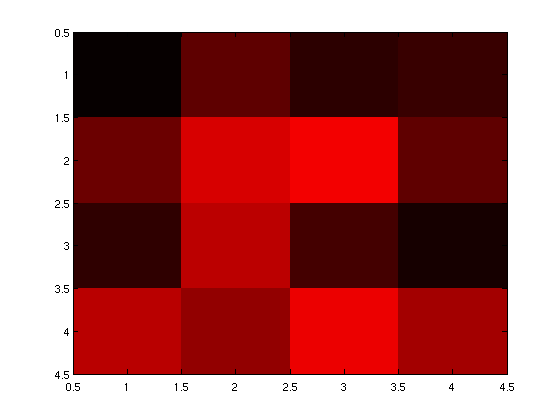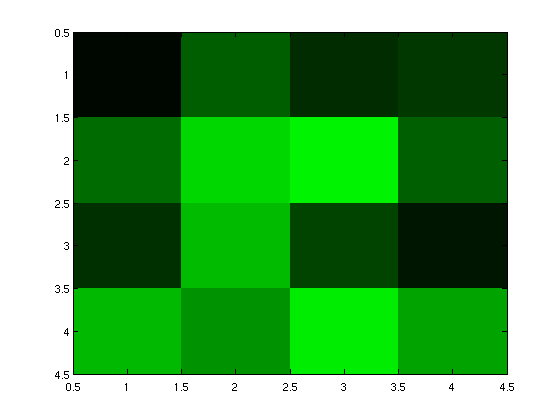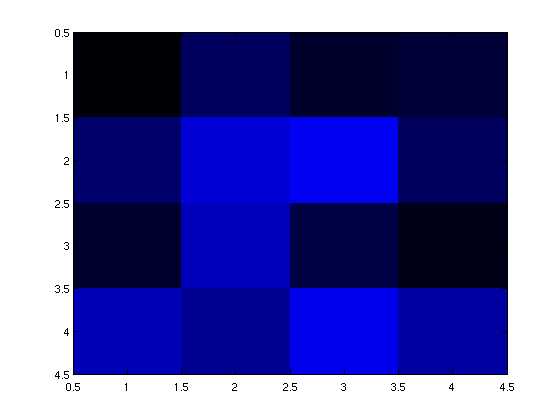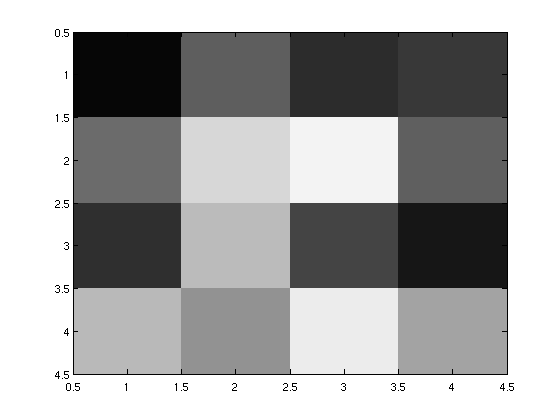Matrices And Color
This page describes how one can think of a digital images as a vector in a vector space. Essentially, one rearranges the pixel values from the rectangular shape of an image into a one-diminsional list of real numbers (usually integers in [0,255].
Contents
The Image Function
The MATLAB function "image.m" creates an image from a matrix. You pass it the matrix, scaled to have values in [0,1], and it converts each entry in the matrix to a color. Since any color can basically be thought of as a combination of three primary colors (red-green-blue), you can create a full color image by creating a "3-dimensional matrix", or cube.
RandomColorMatrix = 255*rand(4,4,3) figure;
RandomColorMatrix(:,:,1) = 206.3470 83.0876 46.0881 166.6935 190.8978 139.3446 65.1236 237.8165 30.6477 101.7146 5.2366 41.6957 133.8865 105.8488 235.5373 234.8798 RandomColorMatrix(:,:,2) = 202.6378 191.7463 171.1566 99.6443 147.2355 58.3107 182.3792 208.1157 112.2091 16.3677 163.7255 80.9441 65.6915 195.6690 106.8573 207.7076 RandomColorMatrix(:,:,3) = 201.2137 242.4781 160.9531 166.3750 217.3273 113.2109 90.5438 154.2726 128.9373 15.3048 254.2358 98.7476 162.0937 221.0212 57.1637 36.2577

A random color matrix (3 different matrices, stacked like pancakes)
image(1/255*RandomColorMatrix);

A random greyscale matrix (1 random matrix, copied and stacked)
A random can be seen in several different, but really equivalent ways. The first is as either a red, green or blue sheet. MyColors will be a "black matrix" filled with zeros, RandomMatrix is filled with random numbers in [0,1].
RandomMatrix = round(255*rand(4,4))
RandomMatrix =
6 94 45 57
107 215 244 95
47 187 68 22
185 146 236 163
In red
MyColors = zeros(4,4,3); MyColors(:,:,1) = RandomMatrix; figure; image(1/255*MyColors);

In green
MyColors = zeros(4,4,3); MyColors(:,:,2) = RandomMatrix; figure; image(1/255*MyColors);

In blue
MyColors = zeros(4,4,3); MyColors(:,:,3) = RandomMatrix; figure; image(1/255*MyColors);

In grey
MyColors = zeros(4,4,3); MyColors(:,:,1) = RandomMatrix; MyColors(:,:,2) = RandomMatrix; MyColors(:,:,3) = RandomMatrix; figure; image(1/255*MyColors);

Linear combinations of color
Any color can be thought of as a kind of "linear combination" of three basis colors, red, green and blue. For example, if
zero_matrix = zeros(4,4,3); red = zero_matrix; red(:,:,1) = ones(4); green = zero_matrix; green(:,:,2) = ones(4); blue = zero_matrix; blue(:,:,3) = ones(4); % then white is % To see this color we can map the three components of the vector to the three color components expected by the image function (after scaling appropriately).
White as the linear combination
white = 255*red + 255*green + 255*blue; figure; image(1/255*white);

Animations of many linear combinations
%Prepare the new file. Vid = VideoWriter('deform_blue'); open(Vid); h = []; % Initial handle to plot k = 1; % Index of snapshot MyFig = figure; hold on; axis off set(gca,'nextplot','replacechildren','visible','off') % Let the coefficient of the blue vector vary from 0 to 255, and plot the results for c = 0:255 FunnyColor = 45*red + 35*green + c*blue; MaxValue = max(max(max(FunnyColor))); image(1/MaxValue*FunnyColor); frame = getframe(MyFig); writeVideo(Vid,frame); end close(Vid);